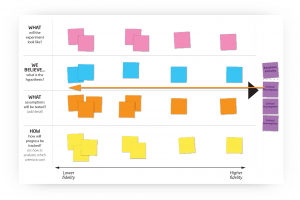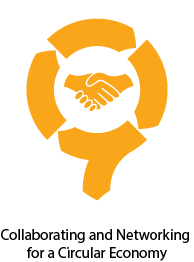About the tool
With the Experiment Design tool, you can identify what low-fidelity and hi-fidelity pilots or experiments can be done. Sometimes this may require building part of the solution: e.g. developing a high-fidelity prototype that offers one or more features of the proposed solution. However, less resource intensive means may also offer an opportunity to learn more. Although limited in functionality, low-fidelity prototypes give insight into the problems your stakeholders face and how valuable your solution is to them.
How to apply the tool?
Step 1: Name the keystone activity and list the critical assumptions
Place the critical assumptions – identified in the previous step – to the right of the diagram. This represent the goal you are working towards: the verification of these assumptions.
Step 2: Work your way backwards devising experiments of different fidelity levels
Devise as many experiments as you need. What is the lowest fidelity experiment that you can think of? Iterate between this step and the next.
Step 3: Clarify the hypothesis of the experiment
Clarify the hypothesis the experiment is designed to test. What is the expected outcome? Go back and forth between this step and the previous, until there is the feeling no lower fidelity experiment can be devised.
Step 4: Add detail to the assumptions that will be tested
In this step verify which of the assumptions will be tested with the experiment.
Step 5: Decide how progress will be tracked
Determine how you know that you are making progress towards your goal.
When to apply the tool?
The Experiment Design tool should be used in the last phase of the process to help in establishing how the transition would happen and how to work with stakeholders.

The Experiment Design is one of the tools presented in the CIRCit project to support various circular value chain configurations, seeking innovation through stakeholder collaboration (WB6).
Read more about the results of this focus area, explore other tools which can help in Collaborating and Networking for a Circular Economy and download the inspiring workbook here.
Downloads


